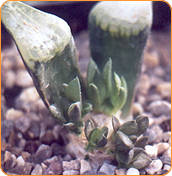







|
 |
 |
 |
 |
 |
 |
Producing offsets (of leaves or
portions of plants) is interesting in several cases :
| • |
to propagate a single plant
in order to obtain one or more identical specimens
: nice hybrids, selected cultivars… |
| • |
to increase the chances
to produce seeds of rare plants or that are difficult
to obtain : indeed if one has only two clones of
a same species the simultaneous flowering doesn’t
always occur and having to wait for the next year
may be disastrous (for example loss of one of the
plants for one reason or another) |
| • |
to propagate plants that
are refusing to offset (solitary plants) |
| • |
to rescue a seriously damaged
plant (fungus attack for example). |
 |
 |
Leaf
offsets :
The chosen leaves need to be strong (swollen). The
results with dried leaves or those with a thin base
are not good as they generally dry too quickly.
With some plants, it is sometimes possible to remove
a leaf to which a small root is attached. Good results
are also obtained when a little piece of stem tissue
is cut together with the leaf. |
 |
 |
Root
offsets :
We tested it accidentally when we depotted one Haworthia
truncata : a nice white root broke at the base and
we decided to plant it again (leaving the broken
point out of the soil) to see what could result.
We were very surprised that it produced several
new plants in a few months. We have tested it with
other fat roots (‘young’ ones) and it
works very well. |
For both offsetting techniques, we respect the following
:
| • |
The taken portions are allowed
to dry out a for a few hours to heal. In case the
cutting is not neat, we apply a little powder fungicide
on it with a small paintbrush. |
| • |
The plants potions are pulled
2-3 mm deep in a light and dry soil
mix to which about 10% of coir is added (only
for offsets). |
| • |
The soil is moistened only
2 days after ‘planting’’ and is always
maintained slightly humid in a shady place at temperatures
ranging between 20 and 28°C. |
| • |
When the first roots and/or
little offsets begin to appear (after a few weeks),
the soil is allowed to dry a little but not completely
before we moisten it again. |
When the offsets have developed good small roots, it is
possible de withdraw them from the ‘mother part’
(leaf or root) and to reuse it again for further offset
production. For example we obtained about 20 offsets from
a fat broad leaf of H. comptoniana.
The small new plants are placed in their groups when they
have reached a size allowing them to face the light and
growing conditions of the collection plants.
 |
 |
Head-removing
offsets:
Another propagation method consists in removing
the head a plant. It is an interesting technique
to propagate solitary species with thin leaves like
lockwoodii or semiviva for example.
The central part of the plant (rosette) is cut away
up to the stem, leaving a few side leaves. The head
is allowed to heal and is placed on soil to produce
new roots.
Some new plants will appear and develop on and/or
around the hurt part. When they are big enough (2-3
cm in diameter), they are taken and treated like
offsets.
We didn’t test this technique of propagation
yet but will try it one day. At present we don’t
cut heads ! The photo illustrating it comes from
Cok Grootscholten who gave it to us for the site
purpose. Thank you Cok ! |
As our glasshouse is not indefinitely extensible, we can
sometimes propose plants that we have propagated or seedlings.
If you are interested, just ask us by e-mail ! |
| |
 |
| |
|
|
|


